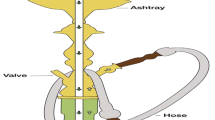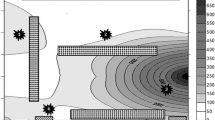Abstract
It has been proven that exposure to bioaerosols is associated with several health effects, such as pulmonary diseases and allergies. The present cross-sectional study was aimed to investigate fungal contamination in indoor air and on the surfaces of four traditional baths in Shiraz, Iran, one of the most historical cities in the world. Samples were taken from indoor air, using a microbial air sampler, as well as the surfaces of the shower, hallway, and dressing rooms of studied baths for 3 months. Totally 180 samples, including 45 air and 135 surfaces samples, were collected from studied baths. The concentrations of fungi collected from the air of studied baths were ranged from 22.6 to 34.6 CFU/m3. Besides, the levels of fungi collected from the surface samples of studied baths were ranged from 21.2 to 60 CFU/m2. The highest and lowest fungi species detected both in air and surfaces samples of the studied baths were Penicillium spp. and Mucor spp. respectively. Although the levels of fungi in the studied baths were lower than the levels recommended by the World Health Organization, some environmental health measures such as washing and disinfecting surfaces and tools after each working shift and periodic inspections are recommended ensuring the safety of costumers who are visiting such places.



Similar content being viewed by others
References
Neisi A, Vosoughi M, Idani E, Goudarzi G, Takdastan A, Babaei AA, et al. Comparison of normal and dusty day impacts on fractional exhaled nitric oxide and lung function in healthy children in Ahvaz, Iran. Environ Sci Pollut Res. 2017;24(13):12360–71.
Dianat M, Radmanesh E, Badavi M, Goudarzi G, Mard SA. The effects of PM 10 on electrocardiogram parameters, blood pressure and oxidative stress in healthy rats: the protective effects of vanillic acid. Environ Sci Pollut Res. 2016;23(19):19551–60.
Bernstein JA, Alexis N, Bacchus H, Bernstein IL, Fritz P, Horner E, et al. The health effects of non-industrial indoor air pollution. J Allergy Clin Immunol. 2008;121(3):585–91.
Ramos CA, Viegas C, Verde SC, Wolterbeek HT, Almeida SM. Characterizing the fungal and bacterial microflora and concentrations in fitness centres. Indoor Built Environ. 2015;25(6):872–82.
Brągoszewska E. Exposure to bacterial and fungal aerosols: microorganism indices in a waste-sorting Plant in Poland. Int J Environ Res Public Health. 2019;16(18):3308.
Medrela-Kuder E. Seasonal variations in the occurrence of culturable airborne fungi in outdoor and indoor air in Crac??w. Int Biodeterior Biodegradation. 2003;52:203–5.
Oliveira M, Ribeiro H, Abreu I. Annual variation of fungal spores in atmosphere of Porto: 2003. Ann Agric Environ Med. 2005;12(2):309–15.
Sepahvand A, Azimi F, Hashemi SY, Rashidi R, Safari M, Zeidali S. General hospitals indoor air quality in Lorestan, Iran. J Air Pollut Health. 2017;2(1).
Garcia-Solache MA, Casadevall A. Global warming will bring new fungal diseases for mammals. mBio. 2010;1(1):e00061–10.
Mendell MJ, Mirer AG, Cheung K, Tong M, Douwes J. Respiratory and allergic health effects of dampness, mold, and dampness-related agents: a review of the epidemiologic evidence. Environ Health Perspect. 2011;119(6):748–56.
Bahkali P. Fungal flora in house dust in Riyadh. Saudi Arabia Mycoses. 1999;42(4):339–43.
Quansah R, Jaakkola MS, Hugg TT, Heikkinen SA, Jaakkola JJ. Residential dampness and molds and the risk of developing asthma: a systematic review and meta-analysis. PLoS One. 2012;7(11):e47526.
Fisk WJ, Lei-Gomez Q, Mendell MJ. Meta-analyses of the associations of respiratory health effects with dampness and mold in homes. Indoor Air. 2007;17(4):284–96.
Havlickova B, Czaika VA, Friedrich M. Epidemiological trends in skin mycoses worldwide. Mycoses. 2008;51(Suppl 4):2–15.
Menezes EA, Carvalho PG, Trindade ECPM, Madeira Sobrinho G, Cunha FA, Castro FFM. Airborne fungi causing respiratory allergy in patients from Fortaleza, Ceará, Brazil. Jornal Brasileiro de Patologia e Medicina Laboratorial. 2004;40(2):79–84.
Brandi G, Sisti M, Paparini A, Gianfranceschi G, Schiavano GF, De Santi M, et al. Swimming pools and fungi: an environmental epidemiology survey in Italian indoor swimming facilities. Int J Environ Health Res. 2007;17(3):197–206.
Chabasse D, Pihet M, Bouchara J-P. Émergence de nouveaux champignons pathogènes en médecine : revue générale. Revue Francophone des Laboratoires. 2009;2009(416):71–86.
Matos T, De Hoog G, De Boer A, De Crom I, Haase G. High prevalence of the neurotrope Exophiala dermatitidis and related oligotrophic black yeasts in sauna facilities. Mycoses. 2002;45(9–10):373–7.
Goksugur N, Karabay O, Kocoglu E. Mycological flora of the Hammams, traditional Turkish bath. Mycoses. 2006;49(5):411–4.
Moriyama Y, Nawata N, Tsuda T, Nitta M. Occurrence of moulds in Japanese bathrooms. Int Biodeterior Biodegradation. 1992;30(1):47–55.
Hamada N, Abe N. Physiological characteristics of 13 common fungal species in bathrooms. Mycoscience. 2009;50(6):421–9.
Cherif-Seffadj N. Medieval and ottoman Hammams of Algeria: elements for a historical study of baths architecture in North Africa. Archnet-IJAR: International Journal of Architectural Research; 2009.
Ouaffak Z. Zaim, Lyagoubi, Laboratoire de Mycologie. Département de Parasitologie. Institut national d'Hygiène MAR. Flore fongique pathogene des bains maures de Rabat (Maroc).; pathogenic fungal flora in Moorish baths of Rabat (Morroco). J Mycol Med. 2003;13(1):19–23.
Bastuji-Garin S, Turki H, Mokhtar I, Nouira R, Fazaa B, Jomaa B, et al. Possible relation of Tunisian pemphigus with traditional cosmetics: a multicenter case-control study. Am J Epidemiol. 2002;155(3):249–56.
Perdelli F, Cristina M, Sartini M, Spagnolo A, Dallera M, Ottria G, et al. Fungal contamination in hospital environments. Infect Control Hosp Epidemiol. 2006;27(1):44–7.
Awad AHA, Saeed Y, Shakour AA, Abdellatif NM, Ibrahim YH, Elghanam M, et al. Indoor air fungal pollution of a historical museum, Egypt: a case study. Aerobiologia. 2020:1–13.
Benammar L, Menasria T, Chergui A, Benfiala S, Ayachi A. Indoor fungal contamination of traditional public baths (Hammams). Int Biodeterior Biodegradation. 2017;117:115–22.
Rafiei A, Amirrajab N. Fungal contamination of indoor public swimming pools, Ahwaz, South-West of Iran. Iran J Public Health. 2010;39(3):124–8.
Khodaveisi S, Ghahremani E, Abdolahi P, Soori S, Moradzadeh S, Shamdi A, et al. Investigation of mycological flora in Kurdistan University of Medical Sciences bath hostels in 2011. Sci J Kurdistan Univ Med Sci. 2014;19(3):123–9.
Hoseini M, Jabbari H, Naddafi K, Nabizadeh R, Rahbar M, Yunesian M, et al. Concentration and distribution characteristics of airborne fungi in indoor and outdoor air of Tehran subway stations. Aerobiologia. 2013;29(3):355–63.
Shahsavani S, Dehghani M, Hoseini M, Fararouei M. Biological monitoring of urinary 1-hydroxypyrene by PAHs exposure among primary school students in shiraz, Iran. Int Arch Occup Environ Health. 2017;90(2):179–87.
Shahsavani S, Hoseini M, Dehghani M, Fararouei M. Characterisation and potential source identification of polycyclic aromatic hydrocarbons in atmospheric particles (PM10) from urban and suburban residential areas in shiraz. Iran Chemosphere. 2017;183:557–64.
Pastor C, Cruz G, Josefina M, Aguilar N, Arroyo O. Fungal and bacterial contamination on indoor surfaces of a Hospital in Mexico. Jundishapur J Microbiol. 2012;5.
Nanbakhsh H, Diba K, Hazarti K. Study of fungal contamination of indoor public swimming pools in Uromia, Iran. Iranian J Publ Health. 2004;33:60–6560.
Naddafi K, Jabbari H, Hoseini M, Nabizade R, Rahbar M, Yunesian M. Investigation of indoor and outdoor air bacterial density in Tehran subway system. Iran. J. Environ. Health. Sci. Eng. 2011;8(4):381–6.
Azimi F, Naddafi K, Nabizadeh R, Hassanvand MS, Alimohammadi M, Afhami S, et al. Fungal air quality in hospital rooms: a case study in Tehran, Iran. J Environ Health Sci Eng. 2013;11(1):30.
Kallawicha K, Chao HJ, Kotchasatan N. Bioaerosol levels and the indoor air quality of laboratories in Bangkok metropolis. Aerobiologia. 2019;35(1):1–14.
Pitt J, Hocking A. Fungi and food spoilage. London, United Kingdom: Blackie Academic and professional; 1997.
Carmichael J, Kendrick WB, Conners I, Sigler L. Genera of hyphomycetes. Univ. Alberta Press; 1980.
Samson R, Hoekstra E, Frisvad J, Filtenborg O. Introduction to food and air borne fungi. 7th ed. Utrecht, the Netherlands: Fungal Biodiversity Centre CBS; 2000. p. 389.
Ripon J. Medical mycology; chapter 5: Mycetoma. 3rd ed. New York: WB Saunders Company; 1988.
Soleimani Z, Goudarzi G, Naddafi K, Sadeghinejad B, Latifi SM, Parhizgari N, et al. Determination of culturable indoor airborne fungi during normal and dust event days in Ahvaz. Iran. Aerobiologia. 2013;29(2):279–90.
Nunes I, Mesquita N, Verde SC, Bandeira AML, Carolino MM, Portugal A, et al. Characterization of an airborne microbial community: a case study in the archive of the University of Coimbra. Portugal Int Biodeterior Biodegradation. 2013;79:36–41.
Picco AM, Rodolfi M. Airborne fungi as biocontaminants at two Milan underground stations. Int Biodeterior Biodegradation. 2000;45(1–2):43–7.
Kim K-Y, Park J-B, Jang G-Y, Kim C-N, Lee K-J. Assessment of bioaerosols in the public buildings of Korea. Indoor Built Environ. 2007;16(5):465–71.
Hamada N. Effect of materials on mold contamination in bathrooms. J Antibac Antifungal Agents (Japan). 2008.
Organization WH. Indoor air quality: biological contaminants: report on a WHO meeting, Rautavaara, 29 August–2 September 1988: World Health Organization. Regional Office for Europe; 1990.
Ekowati Y, Ferrero G, Kennedy MD, de Roda Husman AM, Schets FM. Potential transmission pathways of clinically relevant fungi in indoor swimming pool facilities. Int J Hyg Environ Health. 2018;221(8):1107–15.
Kim KY, Kim YS, Kim D, Kim HT. Exposure level and distribution characteristics of airborne bacteria and fungi in Seoul metropolitan subway stations. Ind Health. 2011;49(2):242–8.
Mirhoseini SH, Didehdar M, Akbari M, Moradzadeh R, Jamshidi R, Torabi S. Indoor exposure to airborne bacteria and fungi in sensitive wards of an academic pediatric hospital. Aerobiologia. 2020:1–8.
Atya AK, Alyasiri MH, Altamimy R, Ethaib S. Assessment of airborne Fungi in indoor environment for biological lab rooms. J Pure Appl Microbiol. 2019;13(4):2281–6.
Leviã JT, Stanković S, Krnjaja V, Bočarov-Stančić A. Fusarium species: the occurrence and the importance in agriculture of Serbia. Zbornik Matice Srpske za Prirodne Nauke. 2009;116:33–48.
Nanbakhsh H, Diba K, Hazarti K. Study of fungal contamination of indoor public swimming pools in Uromia. Iran Environmental Health. 2004;4(4):68.
Peternel R, Culig J, Hrga I. Atmospheric concentrations of Cladosporium spp. and Alternaria spp. sporesin Zagreb (Croatia) and effects of some meteorological factors. Ann Agr Environ Med. 2004;11(2):303–7.
Cho E-M, Hong HJ, Park SH, Yoon DK, Nam Goung SJ, Lee CM. Distribution and influencing factors of airborne Bacteria in public facilities used by pollution-sensitive population: a meta-analysis. Int J Environ Res Public Health. 2019;16(9):1483.
Soleimani Z, Parhizgari N, Dehdari Rad H, Akhoond MR, Kermani M, Marzouni MB, et al. Normal and dusty days comparison of culturable indoor airborne bacteria in Ahvaz. Iran Aerobiologia. 2015;31(2):127–41.
Author information
Authors and Affiliations
Corresponding author
Additional information
Publisher’s note
Springer Nature remains neutral with regard to jurisdictional claims in published maps and institutional affiliations.
Rights and permissions
About this article
Cite this article
Tabatabaei, Z., Rafiee, A., Abbasi, A. et al. Investigation of fungal contamination in indoor air and on surfaces of traditional public baths in a historical city. J Environ Health Sci Engineer 18, 925–932 (2020). https://doi.org/10.1007/s40201-020-00516-6
Received:
Accepted:
Published:
Issue Date:
DOI: https://doi.org/10.1007/s40201-020-00516-6




